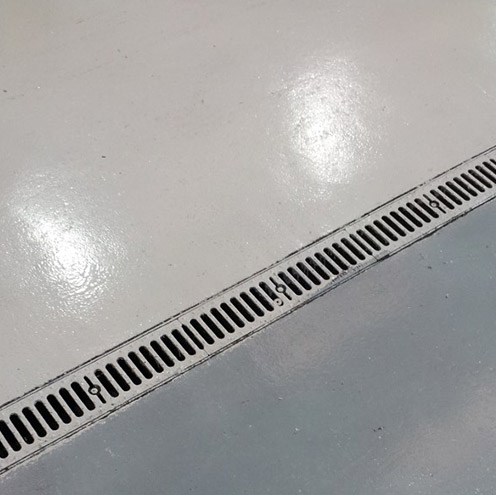
18/05/2006 13:21:16
In the case of newly laid concrete it is important that the concrete has been laid for a minimum of 29 days before considering applying a coating. The moisture content of the concrete should be below 6%. The main problem with the new concrete floors is the weak top surface layer known as laitence. This water rich top layer forms during the drying out period and is mechanically weak. In addition to the poor mechanical properties, the laitance has a chemical composition different from the rest of the concrete.
Concrete floors with the laitence are obviously poor substrates to apply coatings to. It should therefore be a pre-condition that the laitance be removed prior to the application of any floor coating. This is normally carried out by the application of an acid wash, then clean water rinse.
Old Concrete
The Removal of all oils, greases and other solid contamination etc, together with the removal of the remains of any failed coating is required to ensure that a sound base on which to apply a coating or screed is obtained. If a sound base already exists, it should be thoroughly cleaned prior to coating.
Methods Of Concrete Preparation
In order to ensure good adhesion and the long term performance of any floor coating, it is essential that the correct type of surface preparation is carried out.
The following are the recognised methods of preparation:
Abrasive Blast Cleaning
Abrasive blast cleaning should always be the first choice for heavy duty systems, if conditions allow. The blast cleaning is normally carried out using an enclosed system such as Vacu-Blast, Blasttrac or Auto-Blast type machines. These systems are virtually dust free and work on the principal of propelling small particles of abrasive, i.e. steel shot/grit or sand, against the floor surface whilst at the same time vacuum recovering the dust and abrasive to a recovery hopper. In addition to cleaning the floor and removing any laitance, blasting will leave the floor surface with a profile which will enable the coating to gain a physical as well as chemical adhesion to the substrate. Blast cleaning is the recommended system for large floor areas.
Scarifying
Scarifying (sometimes known as scabbing), involves the use of rotating wheels and brushes to scour the concrete surface. The scarifying equipment is pushed over the floor and the enclosed rotating wheels abrade the surface. It is not as efficient or as dust free as A Vacu-Blast machine and can in the wrong hands, cause excessive damage to the substrate. It is most effective on small areas where abrasive blast cleaning cannot be carried out.
Removal Of Chemicals From Floor Surfaces
Concrete that has become contaminated by chemicals must be neutralised before coating. If the surface is acidic, it must be neutralised with an alkaline cleaner and rinsed thoroughly with fresh water. If the contamination is alkaline it can be cleaned with detergent and steam. Oil and great contamination can be removed by a combination of solvents, steam and/or detergents depending on the severity of the contamination.
Flame Cleaning
Where conditions permit, deeply impregnated oils and greases can be removed from concrete floors by flame or superheated compressed air. This method involves the use of heat to bring the oil, grease etc., to the surface and should be carried out under strict supervision with the necessary precautions being taken in view of the possible hazards.
Important
The removal of chemicals, oils, grease and fats must be completed before any other preparation work commences such as blasting acid etching etc.
